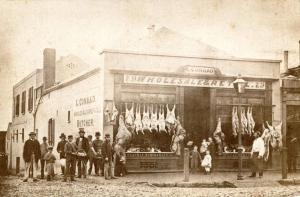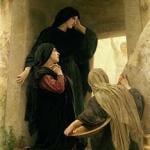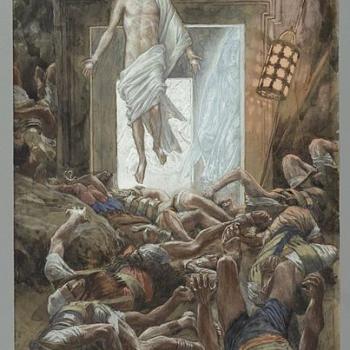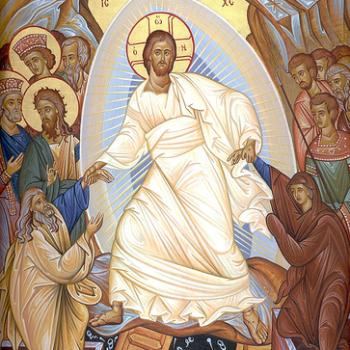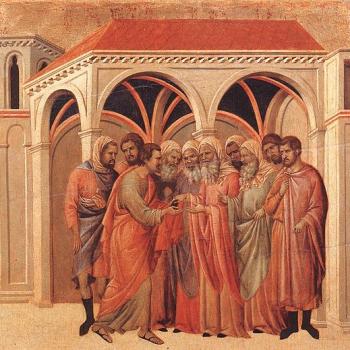Happy Resurrection Easter Day To Everyone.
Easter is not simply a remembrance of something that happened in the past – but as we celebrate it we remind ourselves that the resurrection life is to be an everyday experience. On that first Easter morning the disciples were still experiencing Roman occupation and all that came with it, but the realisation that Jesus was alive and that every promise had been fulfilled changed everything. They would never be the same again – just as we will never be the same again if we claim that same resurrection power. Easter Message
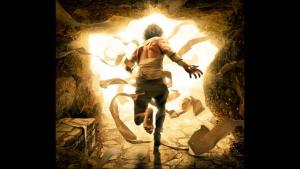
This is the day of days for all followers and believers in Jesus Christ, as by his resurrection death is kicked in the teeth and left wallowing in its grave. It is a day for Joy and Celebration and to Rejoice with our brothers and sisters in faith.
But the question arises for me of how do we treat these siblings in Christ? Those individuals who have been baptised and profess faith in Christ in some way shape or form. How do we treat others who might someday be converted and be baptized in Christ? How do we treat all our fellow human beings no matter what they believe, just because they are created in the imagine and likeness of God?
The title of a particular blog post sums up the attitude and actions all Catholics and Christians should have during this most sacred and holy time during the year.
Holy Week and Easter- A Time to Love Your Neighbor, Not Bash Them
The blogger then goes on to say…
Lent is a time to commemorate the 40 days of Jesus in the desert. Christians spend time in remembrance, self- sacrifice, repentance, fasting and alms-giving. The Holy week for the Christians is a time to remember the last week of Jesus after he entered Jerusalem on Palm Sunday, leading to the crucifixion on good Friday and the resurrection on Easter Sunday.
When Jesus asked his followers to ‘love thy neighbor’, there were no asterisks. He did not say, ‘love thy neighbor except if they are Muslims, blacks, immigrants, Jews…’.
I believe strongly that our respective faiths and religious texts and teachings should serve as an inspiration to unite us, not divide us.
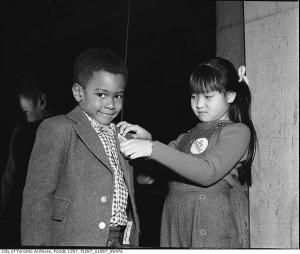
Who wrote this? What faith are they?
It is someone who believes in finding common ground and being civil and kind to others who think and believe differently then themselves.
I have tracked down some pithy nifty sayings about Easter from those of different faith perspectives and compiled them here for you to gaze at and reflect upon. I don’t agree with all philosophical and theological beliefs of all the posters. But I found something of goodness, truth and beauty in the quotes I did find and I believe is common ground to my own convictions about the scope of reality. May they inspire and encourage you as well.
Click on the Link to find out what faith tradition they belong to.
Certainly, we know from archaeological evidence that the corpse of a crucified man might indeed, on occasion, be granted dignified burial in the ossuaries beyond the walls of Jerusalem. Altogether more startling, though—not to say unprecedented—were the stories of what happened next. That women, going to the tomb, had found the entrance stone rolled away. That Jesus, over the course of the next forty days, had appeared to his followers, not as a ghost or a reanimated corpse, but resurrected into a new and glorious form. That he had ascended into heaven and was destined to come again. Time would see him hailed, not just as a man, but as a god. By enduring the most agonising fate imaginable, he had conquered death itself. ‘Therefore God has highly exalted him and bestowed on him the name which is above every name, that at the name of Jesus every knee should bow, in heaven and on earth and under the earth…’
Dominion: How the Christian Revolution Remade the World
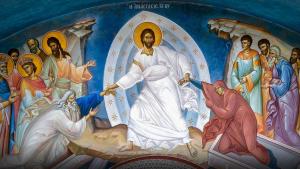
Rejoicing in the Resurrection of Christ, we must not forget those who are struggling, who suffer, or who have no shelter or food, and who are feeble and sick. Let us not forget that in doing good and helping these people, we render honor to the Lord Jesus Himself (Mt. 25:40).
“Death Has Lost Its Power and Authority”

The essential meaning of Easter—for me at least—can be found in a single painting, which I have mentioned here before as my favorite work of devotional art. The painting is by Eugène Burnand, about whom I know nothing else except that he was Swiss. The text it illustrates is in the Gospel of John. And the unwieldy title, “The Disciples Peter and John Running to the tomb on the morning of the Resurrection,” tells us everything we need to know to understand what is going on. Peter and John are running towards the tomb that Jesus was buried in because Mary Magdalene told them that his body was no longer there.
In just a few verses, Jesus will appear to Mary Magdalene, and that same evening, he will appear to all of the apostles (except Thomas) and will confirm the great miracle of the Resurrection. They will feel the nail marks in his hands and the place in his side where the spear pierced him. Doubt will give way to a faith based in sure knowledge, and the disciples will understand the true nature of Christ’s victory over death.
And that is the message of Easter—not just that Christ’s tomb was empty, but that ours will be too. Death’s final victory is not final at all. Easter wants us to believe that the “three score years and ten” allotted to human beings is not all that we get. Something about us survives even the seeming finality of death. As John Donne wrote, “One short sleep past, we wake eternally / And death shall be no more.
Running Towards Hope on the Morning of the Resurrection: An Easter Sermon
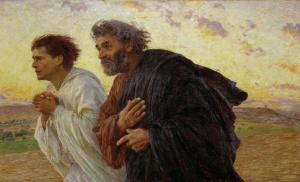
Madder red is the older term for alizarin crimson, known to the pharaohs and the residents of Pompeii. A crucial coloring agent for textiles during the Industrial Revolution, it was also the first plant-derived pigment to be produced synthetically in the nineteenth century.
European folklore is drenched in madder red, believed to avert harm, ward off evil. Association between divine love and the color red existed in ancient Roman. It was said that a hen laid a red egg when Alexander Severus, last of the Severan emperors, was born. The egg signaled Alexander’s claim on divinity in death. Christian lore, with its magpie genius for appropriation, adapted the symbol to its own purposes. In parts of Austria, they say that while the Easter Hare, a famously randy little fellow, produces eggs in a promiscuous range of colors on Easter Sunday, it only lays red ones on Maundy Thursday in honor of the Passion of Christ.
Madder Eggs

You think of bunnies as cute, fuzzy, little darlings who like nothing better than hiding Easter eggs, don’t you? Well, back in the Middle Ages they didn’t give you chocolate. They bloody murdered you! And if you don’t believe me, check out these illustrations, courtesy of The Poke, compiled from a variety of Medieval manuscripts. Happy Nicholas C. Rossis (nicholasrossis.me)
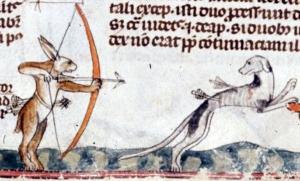
For those in the upper room, and on the Emmaus Road, and in the fishing boat, sight was the sense that next befuddled them, confounding their minds with a confusing appearance, and with familiar words in an unfamiliar voice, his authority speaking to them, but they could not discern him in it. The confirming action came through food, its smell, its taste, the sight of it in his hand, him eating, him inviting them to eat, him breaking bread.
For Thomas, alone, the convincing sense was touch. And he was the only one in all the gospels who touched Jesus ever, after Friday, after he had been laid in the tomb. The reality Thomas sought came through his fingers, more than through his eyes or ears. Thomas the Toucher should be his moniker, in truth.
The Easter of Our Senses
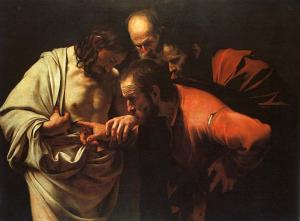
Easter is the reason for our familiarity with life, death, and eternal life. The Easter Gospel recounts the story of what happened after Jesus had been buried in an empty, unused tomb. When the women returned after the Sabbath to care for His body, the tomb was empty (John 20:1-9). The tomb in which Jesus had been buried was no longer a gravesite. It was the site of the ultimate victory of God’s redeeming love; the site of the victory of life over death; the site of the victory of light over darkness; the site of the victory of immortality over immortality.
Before we reach the end of our lives, we must live our entire lives witnessing to the reality that we are “dying to live and living to die.” The life we live now is already a life dead to sin and alive to the power of the Risen Lord. We already live like people who have no permanent graves! May this be true day after day until we are with the Risen Christ. This is the meaning of being a “Resurrection people,” or as they say, an “Alleluia people!”
Dying with Christ to Rise with Him
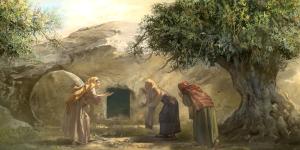
Puzzled. Terrified. Nonsense. Didn’t believe it. Wondering.
These are not words we normally associate with Easter. And yet, here they are in Luke’s Gospel narrative of that first Easter morning. Why would Luke include these details? Luke’s inclusion of these details does not undermine the veracity of their account. If anything, it makes it more believable. And, ultimately, on Easter morning, that is all we are asked to do: to believe the testimony of trauma survivors about the things they have heard and seen and experienced.
But the good news of Easter is that Jesus’s victory over Sin and Death does not depend on how we feel about it on any given day. Jesus’s victory is total, complete, and once-and-for-all. In-deed, it is because of Jesus’s victory over Sin and Death that Paul can write that he is “convinced that nothing can ever separate us from God’s love.”
Puzzled and terrified
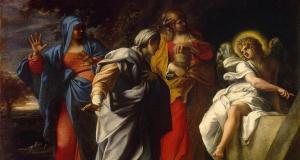
So rather than disregarding the secular aspects of Easter and the other holidays, or allowing them to be minimized or removed by those in charge, let’s take advantage of and extend them. Wear your Easter finery, and walk down the avenue. Deck your home and/or office with Easter lilies, and give Easter eggs to your own and others’ children—but casually explain their meaning. Make sure the Bunny arrives at your house and that the children enjoy what he leaves. If there is any civic recognition of Easter in your town, city, or county, encourage it—even if it is as religiously vague as the Easter Egg Roll on the White House lawn. All of this is essential if these United States are ever to follow Our Lord—and so resurrect as a decent nation.
Saving the Secular Easter
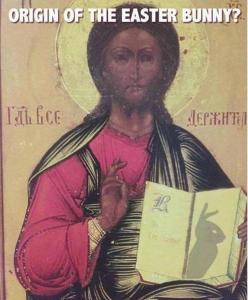
In many churches, Easter egg hunts are popular among children; the Easter bunny is a mythological creature like Santa Claus who is supposed to judge children and determine who’s naughty and nice. Children carry Easter baskets and search high and low to find the coveted Easter eggs and chocolate Easter bunnies. The Easter Egg hunt is not dissimilar to the hunt for the afikomen during Passover. Uncovering an egg hiding under a blade of grass or mound of dirt, just like finding the hidden matzah under a tablecloth or stowed away in a cupboard, can be used to teach children what it might have felt like when the first followers of Jesus found themselves face to face with the Messiah. The Son of God stood before them half-hidden, a man of flesh and blood in ordinary garb; when they realized who he truly was, some of them rejoiced.
Because Resurrection Day falls after the vernal equinox, the holiday also bursts with vibrant spring colors; after the gray waiting and self-abnegation of Lent, Christians decorate churches and homes with Easter lilies and bright flowers; and even dress up in floral patterns and pastels, wearing powder-blue suits or enormous soft pink hats.
Resurrection Day/Easter
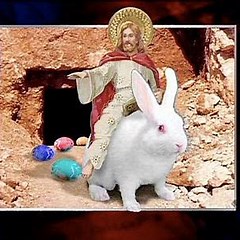
What Faith Are All These People?


